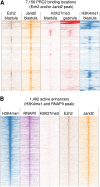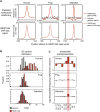Principles of nucleation of H3K27 methylation during embryonic development
- PMID: 24336765
- PMCID: PMC3941105
- DOI: 10.1101/gr.159608.113
Principles of nucleation of H3K27 methylation during embryonic development
Abstract
During embryonic development, maintenance of cell identity and lineage commitment requires the Polycomb-group PRC2 complex, which catalyzes histone H3 lysine 27 trimethylation (H3K27me3). However, the developmental origins of this regulation are unknown. Here we show that H3K27me3 enrichment increases from blastula stages onward in embryos of the Western clawed frog (Xenopus tropicalis) within constrained domains strictly defined by sequence. Strikingly, although PRC2 also binds widely to active enhancers, H3K27me3 is only deposited at a small subset of these sites. Using a Support Vector Machine algorithm, these sequences can be predicted accurately on the basis of DNA sequence alone, with a sequence signature conserved between humans, frogs, and fish. These regions correspond to the subset of blastula-stage DNA methylation-free domains that are depleted for activating promoter motifs, and enriched for motifs of developmental factors. These results imply a genetic-default model in which a preexisting absence of DNA methylation is the major determinant of H3K27 methylation when not opposed by transcriptional activation. The sequence and motif signatures reveal the hierarchical and genetically inheritable features of epigenetic cross-talk that impose constraints on Polycomb regulation and guide H3K27 methylation during the exit of pluripotency.
Figures







Similar articles
-
Developmental enhancers are marked independently of zygotic Nodal signals in Xenopus.Dev Biol. 2014 Nov 1;395(1):38-49. doi: 10.1016/j.ydbio.2014.08.034. Epub 2014 Sep 6. Dev Biol. 2014. PMID: 25205067 Free PMC article.
-
Comparative expression analysis of the H3K27 demethylases, JMJD3 and UTX, with the H3K27 methylase, EZH2, in Xenopus.Int J Dev Biol. 2012;56(4):295-300. doi: 10.1387/ijdb.113360ak. Int J Dev Biol. 2012. PMID: 22562205
-
Temporal uncoupling of the DNA methylome and transcriptional repression during embryogenesis.Genome Res. 2011 Aug;21(8):1313-27. doi: 10.1101/gr.114843.110. Epub 2011 Jun 2. Genome Res. 2011. PMID: 21636662 Free PMC article.
-
The epigenome in early vertebrate development.Genesis. 2012 Mar;50(3):192-206. doi: 10.1002/dvg.20831. Epub 2011 Dec 27. Genesis. 2012. PMID: 22139962 Free PMC article. Review.
-
Ca2+ signaling and early embryonic patterning during the blastula and gastrula periods of zebrafish and Xenopus development.Biochim Biophys Acta. 2006 Nov;1763(11):1192-208. doi: 10.1016/j.bbamcr.2006.08.004. Epub 2006 Aug 5. Biochim Biophys Acta. 2006. PMID: 16962186 Review.
Cited by
-
Control of zygotic genome activation in Xenopus.Curr Top Dev Biol. 2021;145:167-204. doi: 10.1016/bs.ctdb.2021.03.003. Epub 2021 Apr 19. Curr Top Dev Biol. 2021. PMID: 34074529 Free PMC article. Review.
-
Short sequences can efficiently recruit histone H3 lysine 27 trimethylation in the absence of enhancer activity and DNA methylation.Proc Natl Acad Sci U S A. 2014 Aug 19;111(33):E3415-21. doi: 10.1073/pnas.1400672111. Epub 2014 Aug 4. Proc Natl Acad Sci U S A. 2014. PMID: 25092339 Free PMC article.
-
The Unicellular State as a Point Source in a Quantum Biological System.Biology (Basel). 2016 May 27;5(2):25. doi: 10.3390/biology5020025. Biology (Basel). 2016. PMID: 27240413 Free PMC article.
-
Developmental enhancers are marked independently of zygotic Nodal signals in Xenopus.Dev Biol. 2014 Nov 1;395(1):38-49. doi: 10.1016/j.ydbio.2014.08.034. Epub 2014 Sep 6. Dev Biol. 2014. PMID: 25205067 Free PMC article.
-
Lsh Is Essential for Maintaining Global DNA Methylation Levels in Amphibia and Fish and Interacts Directly with Dnmt1.Biomed Res Int. 2015;2015:740637. doi: 10.1155/2015/740637. Epub 2015 Sep 28. Biomed Res Int. 2015. PMID: 26491684 Free PMC article.
References
-
- Akkers RC, Jacobi UG, Veenstra GJC 2012. Chromatin immunoprecipitation analysis of Xenopus embryos. Methods Mol Biol 917: 279–292 - PubMed
Publication types
MeSH terms
Substances
Associated data
- Actions
Grants and funding
LinkOut - more resources
Full Text Sources
Other Literature Sources
Molecular Biology Databases
